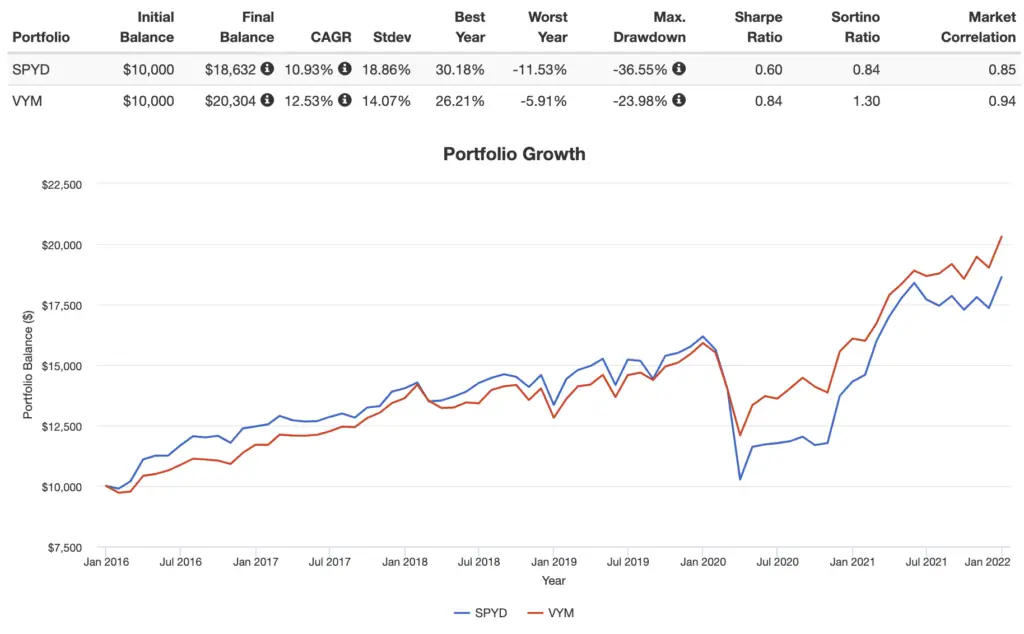Two popular dividend ETFs are SPYD, the SPDR Portfolio S&P 500 High Dividend ETF, and VYM, the Vanguard High Dividend Yield ETF. They're more different than you may realize. Let's compare them.
First, note that I don't chase dividends. But I recognize that many investors use dividends to supplement their current income, particularly in retirement. Others just irrationally prefer dividend-paying stocks. I even designed a dividend-focused portfolio for income investors. In any case, these two funds are very popular and take a pretty different approach. Here we'll review these dividend ETFs and explore the differences between them.
Disclosure: Some of the links on this page are referral links. At no additional cost to you, if you choose to make a purchase or sign up for a service after clicking through those links, I may receive a small commission. This allows me to continue producing high-quality content on this site and pays for the occasional cup of coffee. I have first-hand experience with every product or service I recommend, and I recommend them because I genuinely believe they are useful, not because of the commission I may get. Read more here.
In a hurry? Here are the highlights:
- SPYD and VYM are two popular dividend ETFs from SPDR and Vanguard, respectively.
- SPYD launched in 2015 and VYM launched in 2006.
- SPYD costs a tiny bit more at 7 bps, while VYM costs 6 bps.
- Both are very popular and have significant AUM, but VYM is more popular than SPYD.
- Both funds capture high-dividend-yield stocks in the United States.
- Sector composition differs pretty significantly between these two funds.
- Since SPYD's inception in 2015, VYM has outperformed it on both a general and risk-adjusted basis.
- SPYD has a higher dividend yield than VYM by about half a percent.
Contents
Video
Prefer video? Watch it here:
SPYD vs. VYM – Methodology
SPYD launched in 2015. It is the SPDR Portfolio S&P 500 High Dividend ETF. As the name suggests, SPYD is comprised of a basket of high yield stocks from the S&P 500. Appropriately, SPYD tracks the S&P 500 High Dividend Index. This index is pretty simple. It takes the 80 highest-yielding stocks from the S&P 500 and equally weights them.
VYM is the Vanguard High Dividend Yield ETF. It seeks to track the FTSE® High Dividend Yield Index. Its selection methodology is pretty simple, albeit a little more complex than SPYD. VYM ranks U.S. stocks by 12-month forecasted dividend yield, excludes REITs, selects the top half, and then weights them by market cap.
SPYD and VYM have an overlap of only about 27%. This is illustrated more clearly in the sector breakdown below.
In terms of factor exposure, compared to VYM, SPYD provides greater exposure across Size, Value, and Profitability. Loadings on Investment are equal. VYM tilts large, with negative loading on Size.
While SPYD and VYM both have significant assets, VYM is much more popular. VYM is also slightly cheaper at 0.06% compared to 0.07% for SPYD.
Yield chasers may appreciate SPYD's higher yield by about half a percent. At the time of writing, SPYD has a dividend yield of 3.99%, compared to 3.18% for VYM.
SPYD vs. VYM – Sector Composition
| SPYD | VYM | |
| Basic Materials | 4.1% | 4.9% |
| Consumer Staples | 11.2% | 13.7% |
| Consumer Discretionary | 2.6% | 8.7% |
| Financials | 14.0% | 23.0% |
| Healthcare | 11.6% | 12.6% |
| Industrials | 1.0% | 9.2% |
| Energy | 17.0% | 7.0% |
| Technology | 2.5% | 10.0% |
| Telecommmunications | 5.8% | 3.3% |
| Utilities | 18.3% | 7.3% |
| Real Estate | 12.0% | 0.0% |
Notice how sector exposure differs pretty wildly between SPYD and VYM for some sectors. For example, SPYD has comparatively very low exposure to Consumer Discretionary, Industrials, and Technology, and drastically overweights Energy, Utilities, and REITs. VYM is much more even across all sectors but obviously excludes REITs and also massively overweights Financials.
SPYD vs. VYM – Performance Backtest
Here's a performance backtest of SPYD and VYM going back to SPYD's inception in 2015 through 2021:

During that time, SPYD has lagged VYM on both a general and risk-adjusted basis. Also notice the much larger max drawdown for SPYD from the March 2020 crash and its considerably greater volatility compared to VYM.
SPYD vs. VYM – Conclusion
If you're solely focused on yield and/or prefer to massively overweight Utilities, REITs, and Energy relative to both VYM and the broader market, SPYD may be of use. If instead you want to make sector bets on Financials, maintain some tech exposure, and exclude REITs, you may like VYM more.
In any case, in my opinion, neither of these funds is perfectly suitable as a core holding in a well-diversified portfolio. Moreover, if one wants to target the factor exposure that explains returns between diversified portfolios, you may be better off simply using funds that directly target those factors.
Conveniently, both SPYD and VYM should be available at any major broker, including M1 Finance, which is the one I'm usually suggesting around here.
Do you own either of these dividend funds in your portfolio? Let me know in the comments.
Disclaimer: While I love diving into investing-related data and playing around with backtests, this is not financial advice, investing advice, or tax advice. The information on this website is for informational, educational, and entertainment purposes only. Investment products discussed (ETFs, mutual funds, etc.) are for illustrative purposes only. It is not a research report. It is not a recommendation to buy, sell, or otherwise transact in any of the products mentioned. I always attempt to ensure the accuracy of information presented but that accuracy cannot be guaranteed. Do your own due diligence. I mention M1 Finance a lot around here. M1 does not provide investment advice, and this is not an offer or solicitation of an offer, or advice to buy or sell any security, and you are encouraged to consult your personal investment, legal, and tax advisors. Hypothetical examples used, such as historical backtests, do not reflect any specific investments, are for illustrative purposes only, and should not be considered an offer to buy or sell any products. All investing involves risk, including the risk of losing the money you invest. Past performance does not guarantee future results. Opinions are my own and do not represent those of other parties mentioned. Read my lengthier disclaimer here.

Are you nearing or in retirement? Use my link here to get a free holistic financial plan and to take advantage of 25% exclusive savings on financial planning and wealth management services from fiduciary advisors at Retirable to manage your savings, spend smarter, and navigate key decisions.

Leave a Reply